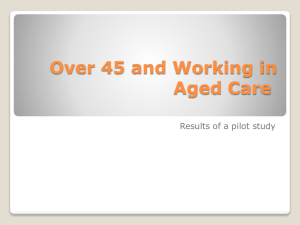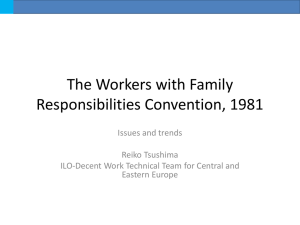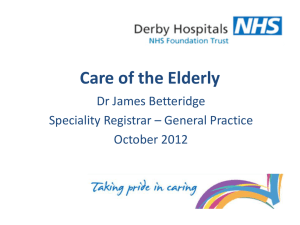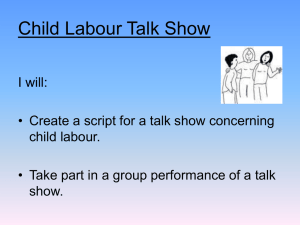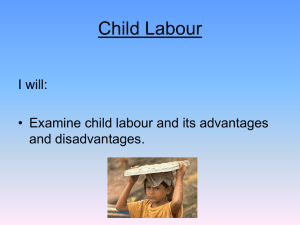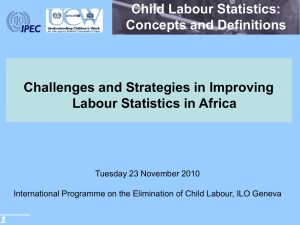economic activities
advertisement
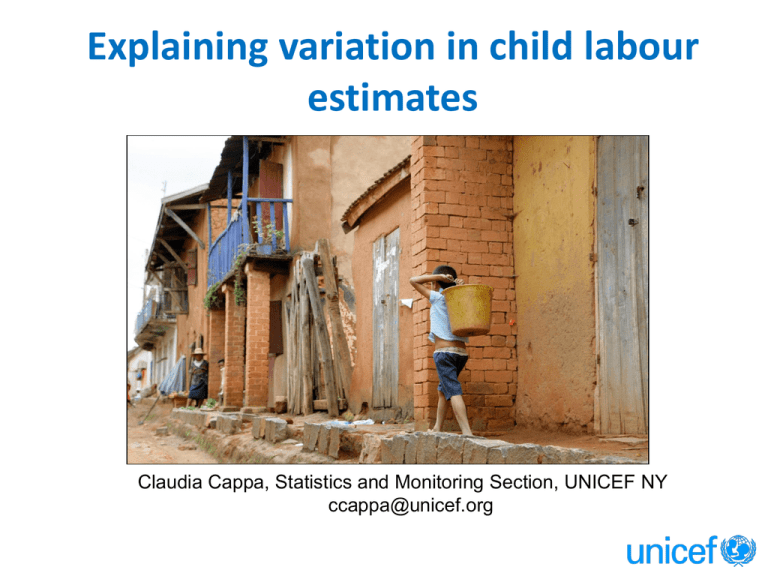
Explaining variation in child labour estimates Claudia Cappa, Statistics and Monitoring Section, UNICEF NY ccappa@unicef.org Objectives • Review concepts, definitions, data sources and measurement tools • Describe some of the methodological challenges related to the measurement of child labour • Present current and planned activities in this area Background • Legal standards define the problem and the underlying concepts in general terms • Child labourers: children who are too young to work and children involved in work potentially harmful to their physical, psychological, social or educational development • Difference between child labour and child work • Currently there is no internationally accepted measure of child labour • Controversial elements: how to quantify harm/hazard Parameters for measuring child labour • Age of the child : 5-11, 12-14, 15-17 • Type of activities (economic, unpaid household services, worst forms of child labour other than hazardous work) • Intensity of work (i.e. average number of hours spent in a week) • Working conditions (heavy loads, confined spaces, dust/fumes, etc.) Work activities • Economic activity = any paid or unpaid work for someone who is not a member of the household or work for a family farm or business (1993 UN System of National Accounts – activities included in GDP) • Unpaid household services (household chores) = cooking, cleaning, washing, shopping and caring for children, old or sick people Differences between UNICEF and ILO Nature of the differences • Differences in questionnaire (content, structure and respondents) • Differences in operational definitions/indicators • Differences in reporting • Differences in implementation protocols and technical assistance Different country estimates Different global estimates Differences in child labour estimates 60 50 44 40 35 29 30 26.1 22 20 13 11.2 10 8 0 Children 10-14 in economic activity Children 10-14 in economic activity Children 10-14 in economic activity Children 10-14 in economic activity SIMPOC 2002/03 DHS 2004 SIMPOC 1998/99 MICS 2000 Bangladesh Kenya Children 5-17 in Children 5-14 in Children 10-14 in economic activity child labour (UNICEF economic activity definition) Federal Office of Statistics/SIMPOC 2001 Nigeria MICS 2007 Children 10-14 in economic activity SIMPOC 2005 Senegal DHS 2005 UNICEF’S and ILO’s standard definitions • UNICEF = involvement in unpaid household services and/or in economic activities - Children aged 5–11 years engaged in at least 1 hour of economic work or 28 hours of domestic work per week Children aged 12–14 years engaged in at least 14 hours of economic work or 28 hours of domestic work per week Children aged 15-17 years engaged in at least 43 hours of economic work or domestic work per week Children of any age in hazardous working conditions • ILO = involvement in economic activities only - Children aged 5–11 years engaged in at least 1 hour of economic work Children aged 12–14 years engaged in at least 14 hours of economic work Children aged 15-17 years engaged in at least 43 hours of economic work Children of any age in hazardous working conditions Framework for the statistical identification of child labor General production boundary SNA production Worst forms of child labor Age group Light work Children 5–11 years of age Children 12–14 years of age Children 15–17 years of age Non-SNA production Regular work NA Any activity even for at least one hour Less than 14 or 14 more hrs/week hrs/week Less than 43 or 43 more hrs/week hrs/week Hazardous work Worst forms of child labor other than hazardous work Employment for Children trafficked 43 hrs or more per for work; forced week or under and bonded child hazardous labor; commercial conditions sexual exploitation of children; use of children for illicit activities and armed conflict In bold: Denote activities that are considered child labor. Reference: adapted from Dayioglu (2012). Hazardous Other unpaid non-SNA household production services Hours Household threshold? chores that are not hazardous Hours threshold? Hours threshold? SIMPOC surveys • Commissioned by governments and implemented with technical support from ILO • Not conducted at regular intervals • Some 60 surveys conducted so far since 1993 • Use module questionnaire (with country adaptations) but national definitions of child labour used to calculate prevalence The case of Rwanda: national definition • Child Labour Survey of 2008 • Child labourers: children aged 5-17 in economic activities before the minimum age of admission to employment (16 years of age) • NOT included (regardless of the intensity of work): children helping parents around the house, assisting in a family business or earning pocket money outside school hours and during school holidays • Applying the national definition, only 6.6% of children aged 5-17 years were considered child labourers Impact of fetching water/collecting firewood on child labour estimates Background • Fetching water and collecting firewood included in the UN System of National Accounts (SNA) as economic activities (1993, Statistical Commission) • MICS3 = fetching water or collecting firewood as household chores (at least 28 hours per week) • MICS4 = fetching water or collecting firewood as economic activities (at least 1/14 hours per week) • New estimates also recalculated for DHS surveys that used MICS4 modules (Burkina Faso, Burundi, Rwanda) Children engaged in fetching water/collecting firewood, by age groups and by hours Children aged 5-11 Less than 1 hour Children aged 5-11 1-13 hours Children aged 5-11 14+ hours Children aged 12-14 Less than 1 hour Children aged 12-14 1-13 hours Children aged 12-14 14+ hours Burundi (DHS 2010) 27.5 63.7 8.9 18.0 66.5 15.5 Rwanda (DHS 2010) 63.3 31.7 5.0 32.4 51.3 16.4 Current and planned activities • New module questionnaire for MICS5 (background data analyses, testing) • Data analysis on household chores and impacts on education to support threshold for household chores • Data analysis on fetching water and collecting firewood • Preparatory meeting with ILO • ICLS 2013 Thank you ccappa@unicef.org
